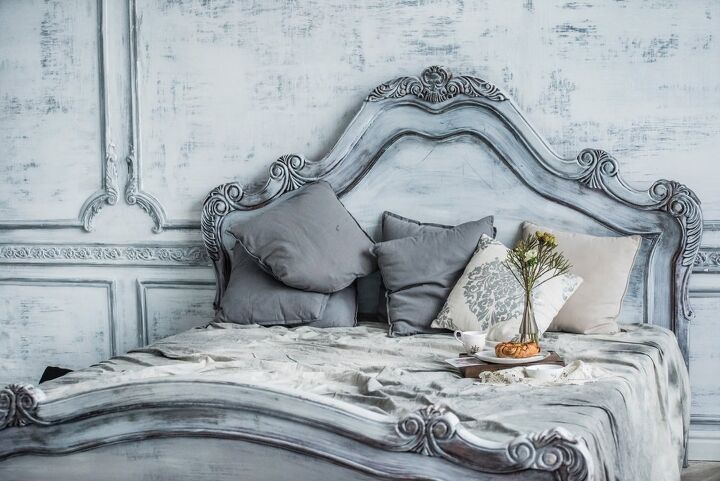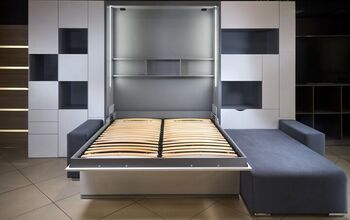What Is A French Bed? (Size, Style, and Pros & Cons)

In search of a way to elevate the styling of the bedroom, many homeowners opt for purchasing a showpiece. For many homeowners, that usually means splurging on a new bed. If you’re interested in taking that approach, then you may want to take a closer look at French beds.
Although French beds are not quite as popular as other comparable options, they still deserve some attention. When it comes to styling and size, you may find that a French bed is exactly what you need.
French beds top out at 140 centimeters in width, meaning they are quite big, but still meant for one person. They can also be made from different materials, including wood, wrought iron, and rattan. Many French beds also feature intricately designed base and headboards that are complemented with other fine details.
Adding a French bed to your bedroom could be the secret to unlocking its design potential. See if buying a French bed makes sense for you as well by continuing with this article.
What is a French Bed?
When browsing through bed options, the French bed often doesn’t come up. There are reasons for that and we’ll get to them later. For now, let’s first get to know what a French bed actually is.
French beds are defined by their size and the way they are designed. Let’s detail those defining qualities better.
What Size is a French Bed?
unique in terms of where they fit in that regard. If you just want a bed for yourself, you’re probably thinking of buying a single bed. Some folks find single beds to be too small though so they may opt for a twin bed or potentially a double bed.
Fortunately, the French bed can serve as an ideal option if you’re struggling to find a bed that fits you properly. Most French beds measure 115 to 140 centimeters across. That means they top out at around 55 inches in width. French beds are essentially equivalent to a one and a half twin bed, meaning they are bigger than a twin, but smaller than a double bed.
You can stretch out a lot if you’re using a French bed. Even with the amount of space they provide, French beds can still fit into a wide variety of rooms.
French Bed Designs
Now that we’ve discussed French bed sizes, we can move on to how they are designed. You can see fine craftsmanship and artistry on full display in French beds. Ornate designs are often carved into the headboards of French beds. Floral patterns are probably the most common, but you can see other designs as well.
The design along the headboard is sometimes limited to the edges, but it can extend beyond there. The price tag of the French bed may also rise in relation to the abundance of the decorative elements present.
The footboards of French beds are crafted carefully. French beds can actually be separated into two different classifications depending on the type of footboard they feature. They can either be straight or curved French beds. Interestingly enough, only the bottom portion and the sides of straight baseboards are completely straight. The upper portion of the baseboard may still be curved and the same goes for the corner edges that lead down.
Straight French beds are more compatible with mattresses. They are the safer option if you haven’t decided on which mattress to purchase just yet. All the elements on curved French beds are rounded. Even the legs are curved. When you look at a curved French bed, you can imagine it being inside the bedrooms of old kings and queens.
The irregular shape of the curved bed’s baseboard does introduce some challenges though. You’ll have to be more selective when it comes to mattresses as not every item pairs well with curved French beds. In general, French beds feature a design that is very reminiscent of old-world royalty. If you’ve long been keen on that kind of aesthetic, French beds are definitely worth a look.
What Are French Beds Made Out Of?
French beds can be crafted from a variety of materials. Learn more about how the material makeup affects the quality of the French bed by checking out the sections below.
Wood
Wood is the number one choice for French beds and with good reason. The material is nice and sturdy while remaining highly customizable. Manufacturers can work with wood easily in order to create those ornate patterns that define French beds.
If you’ve decided to purchase a wooden French bed, you’ll need to be more specific. You can choose from lighter or darker types of wood. Pick out the type of wood that you feel will work best with your bedroom décor.
Wrought Iron
Iron is no longer often used to make beds. You can still them if you browse through a selection of French beds though. To be more specific, manufacturers often turn to wrought iron to create French beds.
Wrought iron is known for its strength. Furthermore, a French bed made from wrought iron has an appearance reminiscent of old-world design. It’s also worth noting that French beds made using wrought iron last for a remarkably long time.
The only real downside to wrought iron French beds is cost. Wrought iron French beds will probably be among the most expensive options you’ll see.
Rattan
French beds may also be made out of the material known as rattan. Rattan furniture is also commonly referred to as wicker furniture.
Rattan is a sustainable material and that’s a big reason why it has become so popular. Pieces of rattan furniture also hold up well to sunlight. That benefit may not matter all that much for a French bed though.
Unfortunately, rattan doesn’t hold up as well as wood or wrought iron. You can still make rattan last for a long time by caring for it properly. Even so, wood and wrought iron simply just last longer.
The Advantages of French Beds
For the following sections, we’ll focus on the advantages and disadvantages of using French beds. We’ll start by discussing the advantages first.
French Beds Work as Centerpieces
If you’re looking for a piece of furniture to showcase in your bedroom, you cannot go wrong with a French bed. They work exceptionally well as the eye-catching piece of your bedroom décor because of how they are designed.
The look French beds feature is also quite unique. You’re not getting that same kind of look from other pieces of furniture in your home.
French Beds Can Inform the Way You Decorate
What we also like about French beds is that you can decorate your room with them in mind. Take inspiration from the way the French bed looks and create a design scheme that pairs well with it. The end result could be something truly spectacular.
French Beds Are Very Comfortable
The size of the French bed makes it very conducive to relaxing nights. Sprawl out as much as you like on top of the bed and fall asleep that way if you prefer.
Although French beds are typically used by one person, it’s definitely big enough for two. Your kid can even squeeze in there if they’re feeling a bit scared of the dark.
The Disadvantages of French Beds
Let’s move to the disadvantages of using French beds now. Make sure you weigh these disadvantages carefully before making any kind of purchase.
French Beds Won’t Fit Comfortably into All Kinds of Bedrooms
The size of your bedroom could determine whether a French bed is a wise purchase for you. French beds are on the bigger side and you’ll need a large room to properly accommodate them. Try to fit a French bed into a small room and you may find it difficult to get comfortable.
French Beds Are Expensive
Compared to standard bed styles, French beds can be very pricey. Some of them also have to be imported and that tacks on a considerable amount of dollars to the price tag. You can argue that French beds are worth the high cost, but they are still not realistic purchases for everyone.
Related Questions
Is a French bed the same as a small double bed?
No, small double beds and French beds are not the same thing. They sometimes get confused for one another due to their respective sizes, but they are different even in that regard. Small double beds top out at 120 centimeters while French beds go up to 140 centimeters.Small double beds also lack the styling that French beds are famous for. You can save more money by purchasing a small double bed though.
What is a French bed in a motor home?
You may sometimes hear about French beds being found inside RVs. It’s important to note that your ears are not mistaken.In RVs, French beds are the ones built into the side of the vehicle. A lot of RV owners like French beds because they aren’t as obstructive as island beds. From a design perspective though, the ones used in RVs are not identical to the more traditional French beds.
What is a French bed in a caravan?
In a caravan, a French bed refers to a double bed that is positioned laterally at the rear of the vehicle. It is commonly located adjacent to the bathroom and takes up very little space. The main disadvantage to French beds in caravans is accessibility. When two people are sleeping in the bed, each of them are facing the wall. The dimensions of a French bed in a caravan are as follows:
- Length: up to 200 cm
- Width: up to 140 cm
Generally speaking, French beds can be rather expensive, particularly when you buy them in Europe and have them shipped to the U.S. They range in price from $300 to more than $1,500.
Though, you should also factor in the cost of maintenance, depending on the material that the bed is made of. For example, those that are upholstered or made of a dark wood will typically require more frequent and costly maintenance.

Gary Evans is passionate about home improvement. He loves finding out how to make improvements in the easiest, most practical, and most affordable ways. Upgrading his home kitchen is one of his ongoing hobbies. Gary is also a long-time content creator and enjoys spending his free time tending to his hydroponic vegetable garden.
More by Gary Evans



























